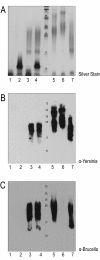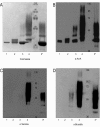Exploiting the Campylobacter jejuni protein glycosylation system for glycoengineering vaccines and diagnostic tools directed against brucellosis
- PMID: 22276812
- PMCID: PMC3298491
- DOI: 10.1186/1475-2859-11-13
Exploiting the Campylobacter jejuni protein glycosylation system for glycoengineering vaccines and diagnostic tools directed against brucellosis
Abstract
Background: Immune responses directed towards surface polysaccharides conjugated to proteins are effective in preventing colonization and infection of bacterial pathogens. Presently, the production of these conjugate vaccines requires intricate synthetic chemistry for obtaining, activating, and attaching the polysaccharides to protein carriers. Glycoproteins generated by engineering bacterial glycosylation machineries have been proposed to be a viable alternative to traditional conjugation methods.
Results: In this work we expressed the C. jejuni oligosaccharyltansferase (OTase) PglB, responsible for N-linked protein glycosylation together with a suitable acceptor protein (AcrA) in Yersinia enterocolitica O9 cells. MS analysis of the acceptor protein demonstrated the transfer of a polymer of N-formylperosamine to AcrA in vivo. Because Y. enterocolitica O9 and Brucella abortus share an identical O polysaccharide structure, we explored the application of the resulting glycoprotein in vaccinology and diagnostics of brucellosis, one of the most common zoonotic diseases with over half a million new cases annually. Injection of the glycoprotein into mice generated an IgG response that recognized the O antigen of Brucella, although this response was not protective against a challenge with a virulent B. abortus strain. The recombinant glycoprotein coated onto magnetic beads was efficient in differentiating between naïve and infected bovine sera.
Conclusion: Bacterial engineered glycoproteins show promising applications for the development on an array of diagnostics and immunoprotective opportunities in the future.
Figures






References
-
- Fugier E, Pappas G, Gorvel JP. Virulence factors in brucellosis: implications for aetiopathogenesis and treatment. Expert Rev Mol Med. 2007;9(35):1–10. - PubMed
Publication types
MeSH terms
Substances
LinkOut - more resources
Full Text Sources
Other Literature Sources

